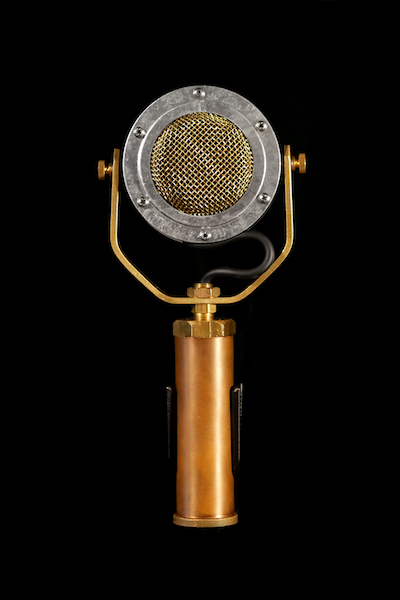by Philip Graham
owner/bricoleur of Ear Trumpet Labs
I spend a lot of time thinking and talking to people about why I’m building condenser microphones rather than dynamics. The short answer is, I like the sound better, and I think when designed right condensers can be as good for live use as any mic out there.
Even though condenser mics are getting wider and wider use in live sound, there remains a common prejudice among many performers that dynamics are somehow inherently better for live use. Usually there’s a belief that dynamics resist feedback better and control bleed from other parts of the stage; coupled with an attitude that any differences in sound won’t matter through a PA. Well, differences between mics are very audible in live settings, especially with modern sound systems. I’ve heard a singer in a jazz club with a modest newer PA switch for one song from my Edwina to a standard 58 that was set up at the piano, and the change was unmistakeable – unmistakably worse. Would you really not care what amp you use for your guitar because it will “probably sound terrible through the PA anyway”?
As for feedback and bleed, it’s all a matter of what the specific microphone is designed for, and how well it is implemented. Both are entirely controlled by the frequency response and polar pattern (directionality) of the mic, and especially the polar pattern across the frequency response. Most people look at polar patterns at 1K, which is in the middle of the mic’s response; but for feedback control the microphone really has to have the same off-axis rejection all across its response range. However, the polar pattern is never the same at all frequencies (except for a ribbon mic’s figure-8 pattern). Almost always, the high frequencies have worse directional control – and it’s usually the high frequencies that are the most problematic for feedback. Taming the off-axis high frequency response can be done through acoustic adjustments to the capsule and careful design of the headbasket, as well as controlling overly-hot high frequencies in the overall EQ of the mic circuitry. I make all these adjustments in my mics, and they have gain-before-feedback that is directly comparable to common stage dynamics like a Shure 58 or an Audix OM5, even in tough acoustic environments.
The big advantage of condenser mics is their sound. A well-built condenser capsule is inherently more capable of a smoother response through the full frequency range than a dynamic. This is simply due to the physics of their construction. The moving part of a dynamic capsule, which is driven by the sound in the air being captured, must have much more mass than the diaphragm of a condenser capsule. It will be much more difficult to make it respond to high frequencies, and it will have severe resonant peaks and valleys at various frequencies. A good dynamic capsule is very carefully designed to add a whole series of these acoustic resonances together, which combine to give a fairly smooth response. But it’s still inherently more irregular and “peaky” than a condenser and less responsive at very high frequencies. Worse high-frequency response is the same as saying that it reproduces transients less accurately. There are certainly some fantastic-sounding dynamics out there – many of which are designed for the studio and are no more appropriate on stage than a U87. But at any rate, a dynamic capsule is a complex mechanism engineered to work in a specific microphone body and cannot very effectively be transplanted and modified, whereas I can control almost every aspect of the sound of my condenser mics.
All of this was brought home for me recently when Ear Trumpet Labs provided the microphones for the Portland Old Time Music Gathering. These were all-acoustic performances; these musicians care a lot about having the tone and quality of their instruments faithfully reproduced – they’d all much rather be completely unamplified, just playing in your living room. The Ear Trumpet mics were mostly used from a distance, usually with Josephine or Louise set up as a conventional bluegrass single mic, with Edwinas and Ednas available for spot micing instruments that needed it, or when the group was spread too far to the sides for the single mic to pick up everyone. Normally these performers are used to using a large-diaphragm condenser intended for studio use; they need the sensitivity and accuracy such a mic gives, but usually they can’t use stage monitors at all with such mics. The Ear Trumpet mics gave them the best of all worlds – the sensitivity to work from a distance, the accuracy to sound completely transparent, and the feedback rejection to be able to monitor. You really can have both great quality sound and the feedback rejection to make stage use easy – not to mention great looks!
Condensers mics need phantom power to operate— see this FAQ for more.
Shop Our Top Single Mics
MYRTLE
LOUISE
DELPHINA
GOT QUESTIONS?
Feel free to get in touch!
503-974-4147
info@eartrumpetlabs.com
2117 NE Oregon St. #303
Portland, OR 97232








 >
>